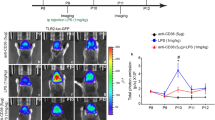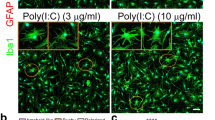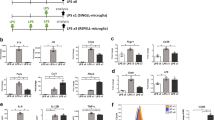Abstract
Microglia, the resident macrophages in the central nervous system (CNS), play a pivotal role in innate and adaptive immune responses in the brain. The immune functions of microglia are regulated by cytokines, including interferon (IFN)-γ, which is a major mediator of macrophage activation. We describe the transcriptional profile of human fetal microglial cells at 1, 6, and 24 h after IFN-γ treatment. The results show a change in the expression of 405 genes including transcriptionally induced chemokines, IFN-γ signaling factors, and major histocompatibility complex genes. Our results demonstrate that activation of microglia by IFN-γ induces proinflammatory T-lymphocyte-related chemokine genes as well as genes involved in antigen presentation. As a result, signals for T-cell infiltration and antigen presentation are produced to allow for microglia–T-cell interactions that likely contribute to defense against invading pathogens. In sum, our results provide a foundation for the molecular mechanisms of the microglial response to IFN-γ—a key to understanding cell-mediated immunity of the CNS.
This is a preview of subscription content, access via your institution
Access options
Subscribe to this journal
Receive 6 digital issues and online access to articles
$119.00 per year
only $19.83 per issue
Buy this article
- Purchase on Springer Link
- Instant access to full article PDF
Prices may be subject to local taxes which are calculated during checkout


Similar content being viewed by others
Accession codes
Accessions
GenBank/EMBL/DDBJ
References
Scolding NJ, Zajicek JP, Wood N, Compston DAS . The pathogenesis of demyelinating disease. Progr Neurobiol 1994; 43: 143–173.
Olsson T . Critical influences of the cytokine orchestration on the outcome of myelin antigen-specific T cell autoimmunity in experimental autoimmune encephalomyelitis and multiple sclerosis. Immunol Rev 1995; 144: 245–268.
del Rio-Hortega P . Cytology and Cellular Pathology of the Nervous System. PB Hoeber: New York, 1932, pp 483–534.
Rock BR, Geccker G, Hu S et al. Role of microglia in central nervous system disorders. Clin Microbiol Rev 2004; 17: 942–964.
Peterson P, Gekker G, Hu S, Chao CC . Microglia: a double-edged sword. In: Peterson P, Remington JS (eds). In Defense of the Brain: Current Concepts in the Immunopathogenesis and Clinical Aspects of CNS Infections. Blackwell Science: Malden, MA, 1997, pp 31–55.
Becher B, Prat A, Antel JP . Brain-immune connection: immuno-regulatory properties of CNS-resident cells. Glia 2000; 29: 293–304.
Aloisi F . The role of microglia and astrocytes in CNS immune surveillance and immunopathology. Adv Exp Med Biol 1999; 468: 123–133.
Stark G, Kerr IM, Williams BR, Silverman RH, Schreiber RD . How cells respond to interferons. Ann Rev Biochem 1998; 67: 227–264.
Flynn J, Chan J, Triebold KJ, Dalton DK, Stewart TA, Bloom BR . An essential role for interferon-gamma in resistance to Mycobacterium tuberculosis infection. J Exp Med 1993; 178: 2249–2254.
Suzuki Y, Conley K, Remington JS . Importance of endogenous IFN-gamma for prevention of toxoplasmic encephalitis in mice. J Immunol 1989; 143: 2045–2050.
Schluter D, Kaefer N, Hof H, Wiestler OD, Deckert-Schluter M . Expression pattern and cellular origin of cytokines in the normal and Toxoplasma gondii-infected murine brain. Am J Pathol 1997; 150: 1021–1035.
Chao CC, Hu S, Gekker G, Novick Jr WJ, Remington JS, Peterson PK . Effects of cytokines on multiplication of Toxoplasma gondii in microglial cells. J Immunol 1993; 150: 3404–3410.
Chao C, Hu S, Peterson PK . Glia-mediated neurotoxicity. In: Peterson P, Remington JS (eds). In Defense of the Brain: Current Concepts in the Immunopathogenesis and Clinical Aspects of CNS Infections. Blackwell Science: Malden, MA, 1997, pp 74–89.
Smith ME, van der Maesen K, Somera FP . Macrophage and microglial responses to cytokines in vitro: phagocytic activity, proteolytic enzyme release, and free radical production. J Neurosci Res 1998; 54: 68–78.
McManus CM, Brosnan CF, Berman JW . Cytokine induction of MIP-1a and MIP-1b in human fetal microglia. J Immunology 1998; 160: 1449–1455.
McManus CM, Liu JSH, Hahn MT et al. Differential induction of chemokines in human microglia by type I and II interferons. Glia 2000; 29: 273–280.
Hoaglin DC, Mosteller F, Tukey JW . Understanding robust and exploratory data analysis. In: Statistical Algorithms Description Document. John Wiley and Sons: Santa Clara, CA, 2002, pp 1–28.
Peterson D, Chandramouli GVR, Geoghegan J et al. Three microarray platforms: an analysis of their concordance in profiling gene expression. BMC Genomics 2005; 6: 63.
Peterson ML, Ault K, Kremer MJ et al. The innate immune system is activated by stimulation of vaginal epithelial cells with Staphylococcus aureus and toxic shock syndrome toxin 1. Infect Immun 2005; 73: 2164–2174.
Mirkin S, Arslan M, Churikov D et al. In search of candidate genes critically expressed in the human endometrium during the window of implantation. Human Reprod 2005; 12: 635–637.
Nau GJ, Richmond JF, Schlesinger A, Jennings EG, Lander ES, Young RA . Human macrophage activation programs induced by bacterial pathogens. Proc Natl Acad Sci USA 2002; 99: 1503–1508.
Bajetto A, Bonavia R, Barbero S, Schettini G . Characterization of chemokines and their receptors in the central nervous system: physiopathological implications. J Neurochem 2002; 82: 1311–1329.
Zheng-Ming W, Liu C, Dziarski R . Chemokines are the main proinflammatory mediators in human monocytes activated by Staphylococcus aureus, peptidoglycan, and endotoxin. J Biol Chem 2000; 275: 20260–20267.
Hua LL, Lee SC . Distinct patterns of stimulus-inducible chemokine mRNA accumulation in human fetal astrocytes and microglia. Glia 2000; 30: 74–81.
Schall TJ, Bacon K, Toy KJ, Goeddel DV . Selective attraction of monocytes and T lymphocytes of the memory phenotype by cytokine RANTES. Nature 1990; 347: 669–671.
Hu S, Chao CC, Ehrlich LC et al. Inhibition of microglial cell RANTES production by IL-10 and TGF-beta. J Leukocyte Biol 1999; 65: 815–821.
Rollins BJ . Monocyte chemoattractant protein 1: a potential regulator of monocyte recruitment in inflammatory disease. Mol Med Today 1996; 2: 198–204.
Baeurmeister K, Burger M, Almanasreh N et al. Distinct regulation of IL-8 and MCP-1 by LPS and interferon-g-treated human peritoneal macrophages. Nephrol Dial Transplant 1998; 13: 1412–1419.
Schall TJ, Bacon K, Camp RD, Kaspari JW, Goeddel DV . Human macrophage inflammatory protein alpha (MIP-1 alpha) and MIP-1 beta chemokines attract distinct populations of lymphocytes. J Exp Med 1993; 177: 1821–1826.
Flynn G, Maru S, Loughlin J, Romero IA, Male D . Regulation of chemokine receptor expression in human microglia and astrocytes. J Neuro Immun 2003; 136: 84–93.
Ehrt S, Schappinger D, Bekiranov S et al. Reprogramming of the macrophage transcriptome in response to interferon-γ and Mycobacterium tuberculosis: signaling roles of nitric oxide synthase-2 and phagocyte oxidase. J Exp Med 2001; 194: 1123–1139.
Baggiolini M, Walz A, Kunkel SL . Neutrophil-activating peptide-1/interleukin 8, a novel cytokine that activates neutrophils. J Clin Invest 1989; 84: 1045–1049.
Walz A, Burgener R, Car B, Baggiolini M, Kunkel SL, Strieter RM . Structure and neutrophil-activating properties of a novel inflammatory peptide (ENA-78) with homology to interleukin 8. J Exp Med 1991; 174: 1355–1362.
Ehrlich LC, Hu S, Sheng WS et al. Cytokine regulation of human microglial cell IL-8 production. J Immunol 1998; 160: 1944–1948.
Panek RB, Benveniste EN . Class II MHC gene expression in microglia: regulation by the cytokines IFN-gamma, TNF-alpha, and TGF-beta. J Immunol 1995; 154: 2846–2854.
Imada K, Leonard WJ . The Jak-Stat Pathway. Mol Immunol 2000; 37: 1–11.
Naka T, Fujimoto M, Kishimoto T . Negative regulation of cytokine signaling: STAT-induced STAT inhibitor. Trends Biochem Sci 1999; 24: 394–398.
Bosisio D, Polentarutti N, Sironi M et al. Stimulation of toll-like receptor 4 expression in human mononuclear phagocytes by interferon-gamma: a molecular basis for priming and synergism with bacterial lipopolysaccharide. Blood 2002; 99: 3427–3431.
Faure E, Thomas L, Xu H, Medvedev A, Equils O, Arditi M . Bacterial lipopolysaccharide and IFN-gamma induce toll-like receptor 2 and toll-like receptor 4 expression in human endothelial cells: role of NF-kappa B activation. J Immunol 2001; 166: 2018–2024.
Bsibsi M, Ravid R, Gveric D, van Noort JM . Broad expression of Toll-like receptors in the human central nervous system. J Neuropathol Exp Neurol 2002; 61: 1013–1021.
Chao CC, Anderson WR, Hu S, Gekker G, Martella A, Peterson PK . Activated microglia inhibit multiplication of Toxoplasma gondii via a nitric oxide mechanism. Clin Immunol Immunopathol 1993; 67: 178–183.
Chao CC, Gekker G, Hu S, Peterson PK . Human microglial cell defense against Toxoplasma gondii. The role of cytokines. J Immunol 1994; 152: 1246–1252.
Chan ED, Chan J, Schluger NW . What is the role of nitric oxide in murine and human host defense against tuberculosis? Current knowledge. Am J Respir Cell Mol Biol 2001; 25: 606–612.
Weinberg JB, Misukonis MA, Shami PJ et al. Human mononuclear phagocyte inducible nitric oxide synthase (iNOS): analysis of iNOS mRNA, iNOS protein, biopterin, and nitric oxide production by blood monocytes and peritoneal macrophages. Blood 1995; 86: 1184–1195.
Peterson PK, Hu S, Anderson WR, Chao CC . Nitric oxide production and neurotoxicity mediated by activated microglia from human versus mouse brain. J Infect Dis 1994; 170: 457–460.
Jungi TW, Adler H, Adler B, Thony M, Krampe M, Peterhans E . Inducible nitric oxide synthase of macrophages. Present knowledge and evidence for species-specific regulation. Vet Immunol Immunopathol 1996; 54: 323–330.
Jesch NK, Dorger M, Enders G et al. Expression of inducible nitric oxide synthase and formation of nitric oxide by alveolar macrophages: an interspecies comparison. Environ Health Perspect 1997; 105 (Suppl 5): 1297–1300.
Chao CC, Hu S, Molitor TW, Shaskan EG, Peterson PK . Activated microglia mediate neuronal cell injury via a nitric oxide mechanism. J Immunol 1992; 149: 2736–2741.
Chao CC, Hu S, Peterson PK . Modulation of human microglial cell superoxide production by cytokines. J Leukocyte Biol 1995; 58: 65–70.
Liu JSH, Amaral TD, Brosnan CF, Lee SC . IFNs are critical regulators of IL-1 receptor antagonist and IL-1 expression in human microglia. J Immunol 1998; 161: 1989–1996.
Acknowledgements
Special thanks to Aaron Becker and Jill Plumb-Smith at the Biomedical Genomic Center, University of Minnesota; Genya Gekker and Wen S Sheng at the Minneapolis Medical Research Foundation; and Wayne Xu at the Supercomputing Institute, University of Minnesota. The Kapur laboratory is supported, in-part, by research grants from the NIH, USDA, NSF, and DHS. BR and BM are supported by the Neurobehavior/Neuroimmune Addiction Research training program at the University of Minnesota funded by the National Institute on Drug Abuse, NIDA T32 DA07097. This work was supported in part by US Public Health Service Grant DA04381.
Author information
Authors and Affiliations
Corresponding author
Additional information
Disclosures
Human fetal brain tissue was obtained under protocol approved by the Human Subjects Research Committee at our institution.
None of the authors has a commercial or other association that might pose a conflict of interest with the current study.
Presented at the Society of Neuroimmune Pharmacology Annual Meeting, April 2004, Santa Fe, New Mexico.
Rights and permissions
About this article
Cite this article
Rock, R., Hu, S., Deshpande, A. et al. Transcriptional response of human microglial cells to interferon-γ. Genes Immun 6, 712–719 (2005). https://doi.org/10.1038/sj.gene.6364246
Received:
Revised:
Accepted:
Published:
Issue Date:
DOI: https://doi.org/10.1038/sj.gene.6364246
Keywords
This article is cited by
-
The role of transforming growth factor β1 /Smad pathway in Alzheimer’s disease inflammation pathology
Molecular Biology Reports (2023)
-
Translocator protein is a marker of activated microglia in rodent models but not human neurodegenerative diseases
Nature Communications (2023)
-
Nos2−/− mice infected with M. tuberculosis develop neurobehavioral changes and immunopathology mimicking human central nervous system tuberculosis
Journal of Neuroinflammation (2022)
-
The lung microbiome regulates brain autoimmunity
Nature (2022)
-
The protective effect of Palmatine on depressive like behavior by modulating microglia polarization in LPS-induced mice
Neurochemical Research (2022)



